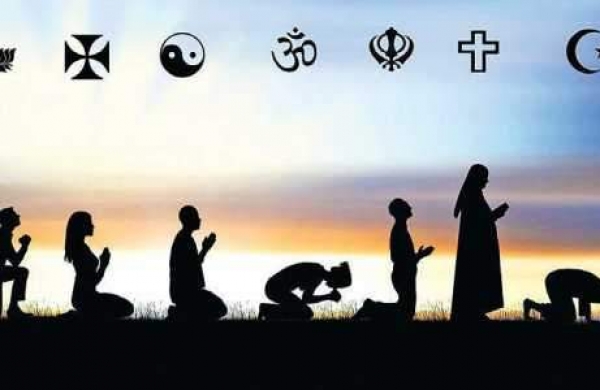This article is written by Riya Jain from the Institute of Law, Nirma University.
Table of Contents
Introduction
Many societies in the subcontinent neither follow the social rules and rituals prescribed by the Brahmans nor were they divided into numerous unequal classes. Such societies are often called tribes. There were many important tribal communities found in every part of the subcontinent like Khokhar in Punjab; the shepherd tribes of Gaddis in the western Himalayas; Nagas, Ahoms in North East; Chero in Bihar and Jharkhand; Mundas and Santhal in Orissa and Bengal; Kolis in Maharashtra and Karnataka; Koragas, Vetars, Maravars in the southern part; Bhils in Central and Western India; Gonds in Chhattisgarh, Madhya Pradesh, Maharashtra and Andhra Pradesh.
Religious conversion can be constructed as a process of acquiring a new religion by leaving one’s religion. The person who converts is called a converter and the person who converts into a new religion is called a convert. Religious conversion has now become a social problem. Religion is the essential part of the Indian subconscious which regulates and manages their life in the direction of righteousness and good life. However, it has now turned the table to indulging people into compelled participation in religious activities. Tribal Communities have been deprived, neglected and coerced to the extent of religious conversion which is an unethical, unconstitutional practice followed by people who think of their religion as the highest and superior mythology of the world. They are of the view that practices, ritual and tradition of their religion makes a man a pure soul and the only redemption of his sin is the religious conversion.
History of tribal conversion in the pre-independence era
The rise of Rajput clans to the position of rulers set an example for the tribal people to follow. Gradually, with the support of the Brahmans, many tribes became part of the caste system. But only the leading tribal families could join the ruling class. A large majority joined the lower jatis of caste society. On the other hand, many dominant tribes of Punjab, Sind and the North-West frontier had adopted Islam quite early. They continued to reject the caste system. The unequal social order, prescribed by orthodox Hinduism, was not widely accepted in these areas.
The emergence of states is closely related to social change amongst tribal people. Two examples of this important part of our history are described below:
- The Gonds lived in a vast forested region called Gondwana – or “country inhabited by Gonds”. They practised shifting cultivation. The large Gond tribe was further divided into many smaller clans. Each clan had its own Raja or Rai. The emergence of large states changed the nature of Gond society. There was basically an equal society gradually divided into unequal social classes. Brahmans received land grants from the Gond Rajas and became more influential. The Gond chiefs now wished to be recognized as Rajputs
- Originally, the Ahoms worshipped their own tribal gods. During the first half of the seventeenth century, however, the influence of Brahmans increased. Temples and Brahmans were granted land by the king.
Varna-based society and tribal people mingle with one another from time to time. This interaction caused both kinds of societies to adapt and change. There were many different tribes and they took up diverse livelihoods. Over a period of time, many of them merged with caste-based society. Others, however, rejected both the caste system and orthodox Hinduism.
History of tribal conversion in the post-independence era
The Indian subcontinent is the birthplace of four major world religions—Hinduism, Buddhism, Sikhism, and Jainism. According to reported 2011 census data, 79.80% of the population of India is Hindu, 14.23% Muslim, 2.30% Christian, 1.72% Sikh, 0.70% Buddhist, and 0.37% Jain.
The law related to conversion was firstly enacted by Hindu Princely states during the British period during 1930 and 1940 for the purpose of preventing Hindu people from the trap of British counterparts for conversion into Christianity and otherwise preserving Hindu ethnicity and identity. The princely states of Kota, Bikaner, Jodhpur, Raigarh, Patna, Surguja, Udaipur, and Kalahandi make law includes the Raigarh State Conversion Act, 1936; the Surguja State Apostasy Act, 1942; and the Udaipur State Anti-Conversion Act, 1946.
The post-independence era attempted to enact laws on anti-conversion like the Indian Conversion (Regulation and Registration) Bill in 1954, Backward Communities (Religious Protection) Bill in 1960, the Freedom of Religion Bill in 1979 but these bills were not passed by parliament due to lack of support. Anti conversion law was reinforced under the NDA government in 2015. It reinstated the harmful repercussion of violation of law relating to conversion to another religion without government consent with harsh punishment. However, all go in vain when the Ministry of Law and Justice declares such enactment as the powerhouse of state subject i.e. falling under state list in the seventh schedule of the Constitution.
State Legislation on Anti Conversion Law
There are eight states (Arunachal Pradesh, Orissa, Madhya Pradesh, Chhattisgarh, Gujarat, Himachal Pradesh, Jharkhand, and Uttarakhand) out of twenty nine states which have enacted upon anti-conversion law for general interest and welfare of the citizen from the clutches of illegal and unlawful coercion of conversion through the force of fraud, coercion, misrepresentation or undue inducement or allurement.
The basic aim of the legislation was to prevent the individual and communities from converting one’s religion of their forefathers to another religion mainly weaker or influential sectors of society namely women, children, backward classes and untouchables. Imposing punishment of fines ranging from Rs. 5000 to Rs.50,000 and imprisonment which may extend to three years, harsh punishment in case converted individuals are women, children, backward classes (ST/SC). Given below are some state legislation on anti conversion:
The Orissa Freedom of Religion Act, 1967
The state of Orissa was the first state to enact a law on anti-conversion in India namely The Orissa Freedom of Religion Act, 1967. Section 3 of the Act stipulates no person shall convert or attempt or abet conversion of any person of religious faith to another religion either directly or otherwise by use of force, or by inducement or by any fraudulent means. The violation of which will lead to imposing a punishment of imprisonment of one year or a fine up to Rs.5000 or both. In case the converted person is women, children, members of ST/SC communities, a punishment may extend up to two years of imprisonment and a fine up to Rs.10,000. The act classifies the crime as a cognizable offence which means police have the competent authority to investigate and arrest offenders without arrest warrant but not below the rank of Inspector of Police.
Moreover, the Orissa Freedom of Religion Rules, 1989 mandates priests performing the conversion ceremony to specify the time, place, date of ceremony and name, address of the person so converted to District Magistrate before 15 days of conversion ceremony. The failure to specify the information would result in a fine of Rs.1000.
Madhya Pradesh Freedom of Religion Act, 1968
The MP was the second state to enact, enforce and implement the Anti Conversion Act namely the Madhya Pradesh Freedom of Religion Act, 1968. The Act prescribed the same enforcement as provided under Section 3 of the Orissa Freedom of Religion Act,1967 but instead of the word ‘inducement’, the act used the term ‘allurement’ which means offering person so converted with either gift or gratification in cash or kind or grant material benefit either monetary or non-monetary terms. The regulation as under punishment is the same as above state law. The notice of conversion shall be given by the priest conducting the ceremony or person so converted under seven days to the District Magistrate.
Supreme Court verdict on Anti Conversion Law
The Supreme Court in the case of Rev Stainislaus v. State of Madhya Pradesh (1977), questioned whether the right to practice, propagate one’s religion includes the right to convert one’s religion to another religion. The court upheld the validity of anti-conversion law while taking the reference of the Madhya Pradesh Dharma Swatantrya Adhiniyam, 1968, and the Orissa Freedom of Religion Act, 1967. The court observed that Article 25(1) of the Constitution of India guarantees the right of freedom of conscience to all citizens of India and is not restricted to particular religion i.e. right to all religion. Moreover, the reasonable restriction subject to public order and if compelled, allurement or inducement or use of fraudulent force not prohibited by operation of law then such would result in public disorder and ‘propagation’ in the Article 25 should be comprehended as peaceful persuasion without coercion and it does not include right to convert any person to one’s religion.
Conflict Between RSS and church in Jharkhand
There was a spark of cold war on religion between Rashtriya Swayamsevak Sangh (RSS), Sarna tribals and Church in relation to the enactment of Jharkhand Freedom of Religion Act, 2017. The RSS was of the opinion that one should not betray one’s mother religion and remain intact with Hinduism which is superior religion of the world, many tribal has started marrying their sons and daughter in accordance with Hindu rituals and practices whereas leaders of tribal communities states that tribal was never Hindu who practices of Varna system classifies the membership of the society according to their birth and occupation. Moreover, they do not preach any God of Hindu mythology but otherwise God of nature and people get influenced by Hindu deities because resolution to problems makes them form an impression that such God is supreme and he must resort to this new faith. Therefore, such authorities must find a way to balance their interest not for personal advantage but for the general interest and welfare of tribal communities.
Demand for recognition for their religion
The tribal communities are protesting for recognition of their right to insert tribes or aboriginal religion as an option of the census or other forms of legal value. Earlier in 1951, tribal religion was included under the ninth option in the list of religions in independent India but has now been removed leading to harm to tribal communities in demanding anything from concerned authorities. Even before 2011 census, there were six communities are religion concerns including Hindu, Muslim, Sikhs, Jains, Christian and Buddhist with others option which was used by tribals but even after 2011 census, it too has been removed and therefore causing prejudice to the whole communities of tribals.
Criticism of Anti Conversion Law
The Anti-Conversion law enacted a restriction on conversion to one’s choice of religion, practice, propagate and promote so converted religion and thereby infringes the right to privacy of individuals. Moreover, it imposes harsh punishment for conversion to weaker sections of society on the fallacious assumption that such classes of people are devoid of given consent either express or implied for their conversion. The mandatory compliance of submission to District Magistrate for approval of religious conversion ceremony before conversion also hurdles the privacy of individuals.
The report of the US Commission on International Religious Freedom (USCIRF) states that to some extent it favours Hinduism over minority religion, the strict intervention of government officials to assess validity, appropriateness and permissibility of the conversion acted as a prerequisite for conversion and failure of which imposes punishment. Thus, all these factors have challenged the constitutional idea of secularism. In addition, these laws have shaken equitable practices among minority communities.
The USCIRF report observed that the process of reconversion to Hinduism under Ghar Wapsi (returning home) has not been mentioned under anti-conversion law. Since the crime relating to religion and therefore any reconversion by use of force, fraudulent act or inducement or allurement has been explicitly exempted from the operation of law with no punishment. The Hindu nationalist group in 2014 initiated the program of Ghar Wapsi for the purpose of reconversion of thousand of individuals from Christian and Muslim families to Hinduism.
The rate of Arrest is more than the rate of conviction because accusations made by weaker sections of society for unlawful conversion by converters do not require supporting evidence to prove wrongdoing committed to them or communities. It creates an environment of fear of malicious prosecution and suspicion of the commission of a crime. The report of USCIRF released in 2017 releases such following instances:
-
Religious leaders of minority communities faced apprehension of being arrested and prosecuted under anti-conversion law. For example, Catholic nuns and four other tribal women were detained based on suspicion of inducing conversion.
-
Christian protested in Ludhiana, Punjab when the pastor of God of Church was killed by the mob upon the suspicion of engaging individuals to conversion.
Conclusion
The conversion of tribal communities into other religions initiated the momentum of social conflict of interest between converted religion and converting religion. It has resulted in westernization, urbanization and industrialization of cultural practices, ritual, occupation, tradition causing harmful repercussions of tribal ethnicity and values. Tribals have started adapting western clothes, custom adopting the Christian marriage system. For example, in the practice of matrimonial practices, there is a tradition of Khasi tribal in which the youngest daughter gets inheritance of property from her mother but if khasi converts them into Christianity then they cannot claim the inheritance of property without claiming their right before court. Many tribes obtained their means of earning from agriculture, hunter-gatherers or herders while they are dependent on the natural resources of their area for their survival. The tribes earlier used to reside in forests, hills; deserts retained their freedom and unique culture. Nowadays, tribes due to strict enforcement of law need to dwell in places outside the strikes of forest areas.
Therefore, it is need of the hour to give communities legal recognition of rights not only in social terms but also in economical, political aspects of the society for the purpose of preservation, protection and welfare of the communities in conformity to their values and ideas.
References
- https://www.uscirf.gov/sites/ default/files/Constitutional and Legal Challenges Faced by Religious Minorities in India.pdf (4 Feb. 2017).
- https://amp.scroll.in/article/714103/how-the-rss-ghar-wapsi-programme-actually-hurts-hindus
- http://www.uscirf.gov/sites/default/ files/2018USCIRFAR.pdf
LawSikho has created a telegram group for exchanging legal knowledge, referrals, and various opportunities. You can click on this link and join:
 Serato DJ Crack 2025Serato DJ PRO Crack
Serato DJ Crack 2025Serato DJ PRO Crack











 Allow notifications
Allow notifications



